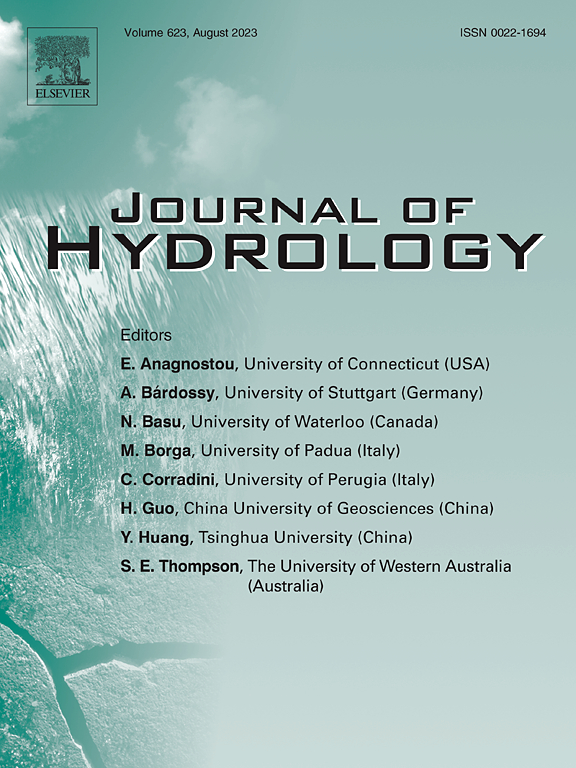亚热带浅湖淹没大型植物栖息地二氧化碳长期动态变化
IF 6.3
1区 地球科学
Q1 ENGINEERING, CIVIL
引用次数: 0
摘要
沉水大型植物分布广泛,被认为是浅水湖泊的基本组成部分。它们通过提供基本的生态系统服务发挥关键作用,然而,它们在控制二氧化碳(CO2)预算方面的作用仍然存在争议和不清楚,可能对湖泊生态系统内二氧化碳循环的全面理解构成重大挑战。为了填补这方面的知识空白,基于2005-2017年不同季节的长期野外测量,对中国东部亚热带浅湖淹没植物栖息地内CO2的动态变化进行了全面研究。研究结果表明,与湖泊开阔水域相比,沉水植物生境具有较好的水质特征,表现为营养负荷低、藻类生物量减少、水体清澈度提高。长期观测表明,沉水植物是一个相对较低的CO2源,年平均排放通量为13.55 ± 9.20 mmol m−2 d−1。大型植物的存在和良好的水质(如低营养负荷)可能分别通过增加二氧化碳固定和减少二氧化碳产生,对淹没大型植物栖息地内的低排放做出了贡献。水下大型植物栖息地CO2排放的时间波动与水的清晰度密切相关,这反过来又突出了水质在决定水下大型植物栖息地CO2变异性中的作用。此外,长期测量揭示了CO2排放的显著年际变化,强调了长期测量对于得出内陆湖泊淹没植物栖息地内CO2预算的无偏估计的重要性。本文章由计算机程序翻译,如有差异,请以英文原文为准。
Long-term carbon dioxide dynamics variability at submerged macrophyte habitat of a subtropical shallow lake
Submerged macrophytes are widespread and deemed fundamental components particularly in shallow lakes. They play a pivotal role by rendering essential ecosystem services, however, their roles in governing the carbon dioxide (CO2) budget remain controversial and unclear, likely posing a significant challenge to the comprehensive understanding of CO2 cycling within lake ecosystems. To fill the knowledge gaps, the dynamic variability of CO2 within the submerged macrophytes habitats in a shallow subtropical lake located in eastern China was comprehensively investigated based on long-term (2005–2017) field measurements span different seasons. The findings revealed that the submerged macrophytes habitats were characterized by superior water quality, manifested as low nutrient loadings, reduced algal biomass, and heightened water clarity, when juxtaposed with open water regions of the lake devoid of macrophytes. The long-term measurements demonstrated that the submerged macrophytes habit functioned as relatively low CO2 source, with an annual mean emissions flux of 13.55 ± 9.20 mmol m−2 d−1. The presence of macrophytes and good water quality (e.g. low nutrient loadings) likely contributed to low emissions within submerged macrophyte habitat via increasing CO2 fixation and reducing CO2 production, respectively. The temporal fluctuations in CO2 emissions from submerged macrophyte habitats were closely associated with water clarity, which in turn highlighted the role of water quality in determining CO2 variability within submerged macrophyte habitats. Furthermore, the long-term measurements uncovered significant inter-annual variations in the CO2 emissions, highlighting the critical importance of long-term measurements to derive unbiased estimates of the CO2 budgets within the submerged macrophyte habitats of inland lakes.
求助全文
通过发布文献求助,成功后即可免费获取论文全文。
去求助
来源期刊

Journal of Hydrology
地学-地球科学综合
CiteScore
11.00
自引率
12.50%
发文量
1309
审稿时长
7.5 months
期刊介绍:
The Journal of Hydrology publishes original research papers and comprehensive reviews in all the subfields of the hydrological sciences including water based management and policy issues that impact on economics and society. These comprise, but are not limited to the physical, chemical, biogeochemical, stochastic and systems aspects of surface and groundwater hydrology, hydrometeorology and hydrogeology. Relevant topics incorporating the insights and methodologies of disciplines such as climatology, water resource systems, hydraulics, agrohydrology, geomorphology, soil science, instrumentation and remote sensing, civil and environmental engineering are included. Social science perspectives on hydrological problems such as resource and ecological economics, environmental sociology, psychology and behavioural science, management and policy analysis are also invited. Multi-and interdisciplinary analyses of hydrological problems are within scope. The science published in the Journal of Hydrology is relevant to catchment scales rather than exclusively to a local scale or site.
 求助内容:
求助内容: 应助结果提醒方式:
应助结果提醒方式:


